
In anticipation of the incoming new 2023 Nissan Z, the Japanese carmaker's Australian arm has released a gallery celebrating the iconic badge's history in Australia. (Although the Z31 is absent – Nissan was unable to secure a suitable car in time for its shoot.)
Sounds like a good excuse for us to revive our own story, offering a more detailed look at the Z's journey from launch in Australia.
The Datsun 240Z was a watershed model that redefined buyer perceptions towards the brand around the world, and kicked off one of Nissan’s most enduring nameplates.
Famously aimed at the US market, Australia also represented a key right-hand drive export market for the fledgling Yokohama brand, receiving some of the earliest Zed builds. On local soil, the original Zed had a profound effect on owners, with its iconic lineage still bolstered by legions of enthusiasts around the nation to this day.
So, let's take a trip down memory lane – and watch for our Australian launch review of the new Z to land later this month.
First Generation: Datsun S30 240Z and 260Z – 1969-1978
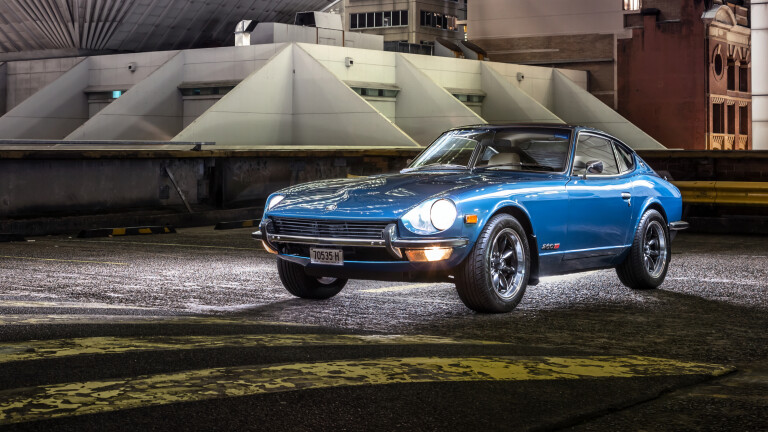
The genesis of Z dates back to a 1964 open-top concept car penned by famed designer Albrecht Goertz. The German industrial designer already had BMW’s 503 and 507 Roadster to his name, and consulted with Nissan throughout the 60s. He is credited with further contributions to the original CSP311 Silvia and a defunct sports car joint-project with Yamaha that eventuated in Toyota’s 2000GT.
Launched locally in September 1970, the 240Z was a genuine 200km/h car in its day and, at $4567, was priced in line with the Triumph TR6 – a car it could comfortably outperform. Australia was the prime right-hand drive export market, receiving 2358 units in total, accounting for the third largest 240Z market in the world, behind USA and Canada.
The original shipment of 319 cars in 1970 included some of the earliest RHD builds in existence. This snippet from Modern Motor’s road test from April 1971 features chassis #4.
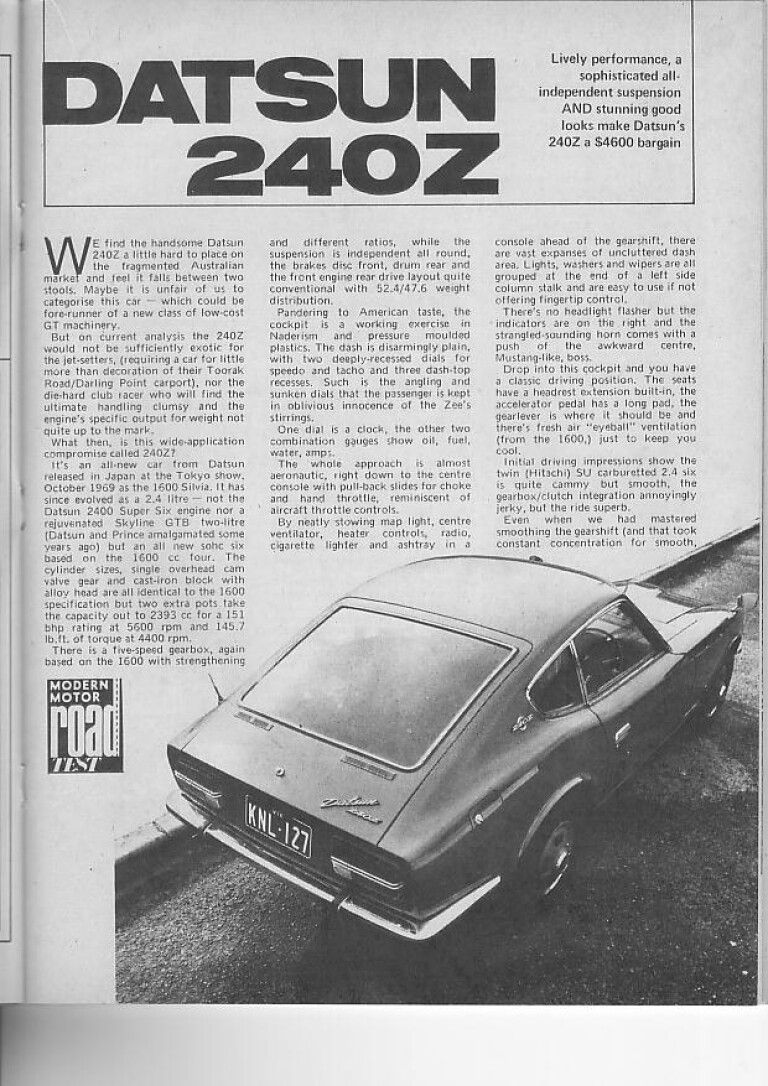
Some Zed specialists argue that early production for the Australian market also streamlined development for other RHD export markets. Subsequently, some assert that, without Australia, the 240Z’s global reach and impact would have been significantly diminished.

Despite its reputation as a democratic champion of affordable performance, in the heyday of 1970, the Zed was a costly machine, exceeding the as-new list price of local heroes like the XW Phase I Falcon, Torana XU-1, and Chrysler E38 Charger.
Globally, the 240Z was a hit, becoming the world’s fastest selling sports coupe within three years of production.
Tightening US emissions regulations throughout the 70s forced an update in the form of the Datsun 260Z.

Again, aimed at the US market, the 260Z’s engine was bored out to 2565cc with a 2+2 variant introduced with an elongated notched roofline and an extra 302mm of wheelbase.
Launched locally in mid-1974, in the midst of fears of global fuel shortages and new US safety regulations, just 1123 260Zs were sent Down Under.
The final iteration of the Zed’s first generation was a US-only 280Z, released from 1975. As the name suggests, it housed a larger 2.8-litre inline-six and introduced fuel-injection to the existing body shape. Australia continued selling the 260Z until 1978.
Second Generation: Datsun S130 280ZX – 1978-1983

The second-generation Zed, the 280ZX, appeared on the local market in 1978 and marked the slow departure from the badge’s sporting roots to a more rounded grand tourer.
The 103kW drawn from the familiar SOHC L28 didn’t make headlines but it was deemed a smooth and strong unit, and delivered respectable performance from the 1265kg coupe. The speedometer could still reach north of 190km/h, and local road testers celebrated its outstanding fuel economy. An 80-litre fuel tank yielded great cruising range and seemed well suited to Australia, too.
Strides were made in regards to interior materials and amenities, introducing power windows and mirrors, air-conditioning, comfier seats and an automatic gearbox. Officially, Australia only received the 2+2 long-wheelbase body however some Japanese-spec HS130 coupes have been imported over the years.
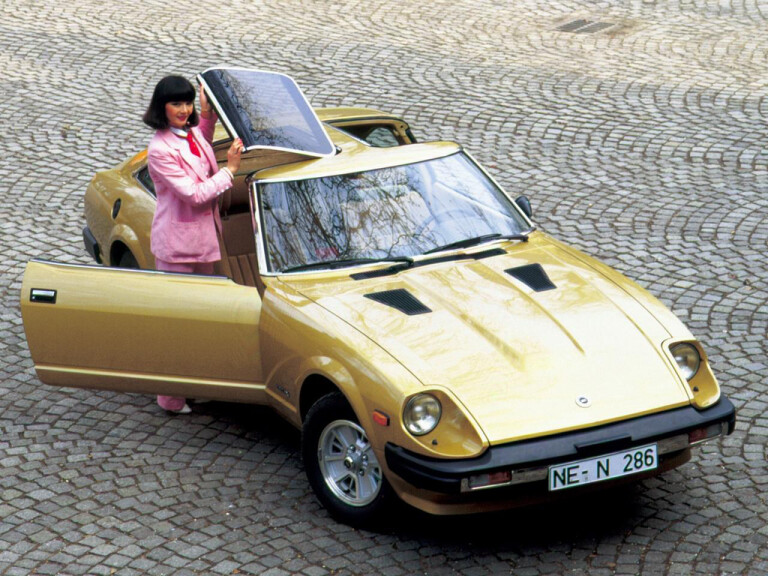
February 1980 saw the brand badge switch from Datsun to Nissan, and also introduced the optional pop-out targa roof panels.
Third Generation: Nissan Z31 300ZX – 1983-1989
EDITOR'S NOTE: Nissan Australia did not include a Z31 in its recent shoot
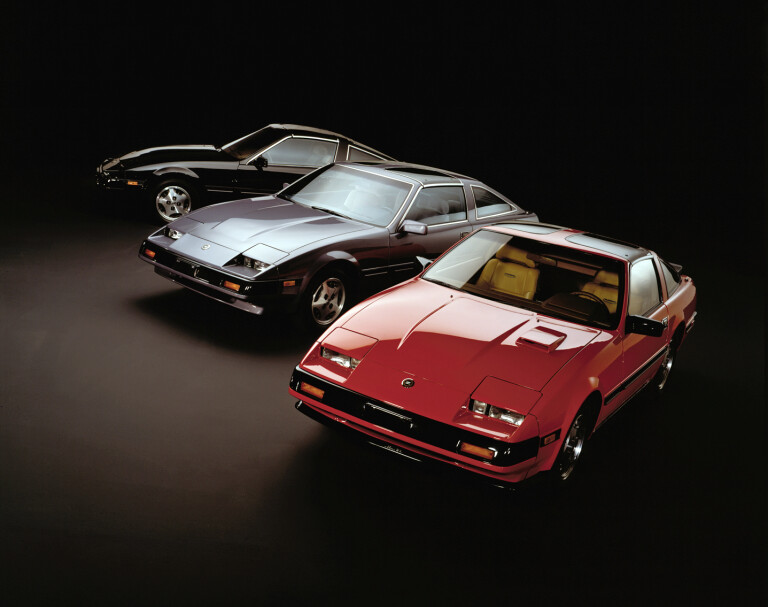
The Z31 300ZX boasted a modern new face but remained largely based on the preceding 280ZX, albeit with a new 3.0-litre VG30 V6, new suspension and a wider stance. It continued to market itself on its American boulevardier image.
Again, Australia’s comparatively small market received just one body option: the 2+2 Targa top. Initially, Australian buyers were solely offered the naturally aspirated V6 yielding a modest 124kW.
From 1986, however, buyers were treated to the 155kW turbocharged version sans adjustable shocks which featured in overseas markets.
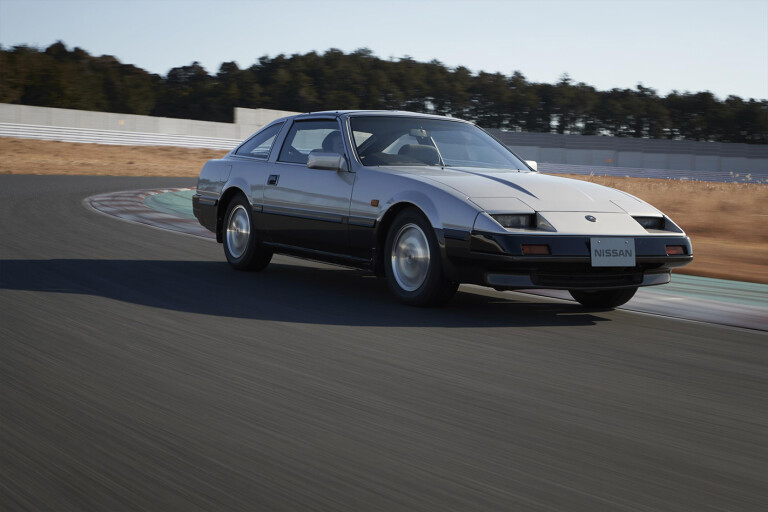
At almost $28,000 new, the 300ZX was a costly machine, offered in just one spec with the only options including climate control and a digital instrument cluster.
Australia uniquely offered the “Californian” special edition, to commemorate the final 200 units of Series III cars sold in Australia.
Fourth Generation: Nissan Z32 300ZX – 1990-1996
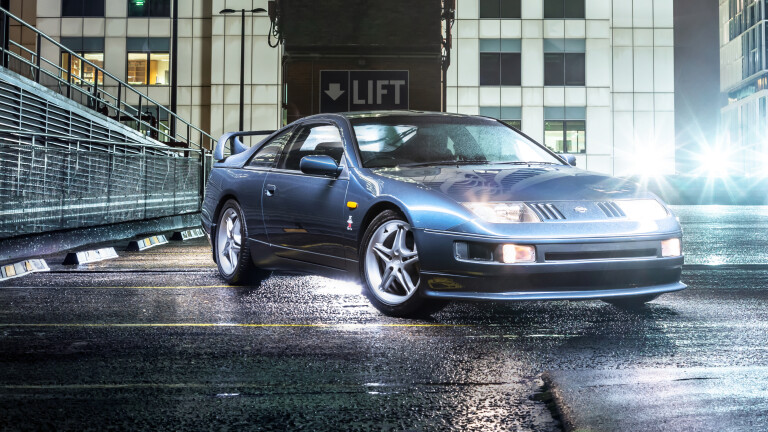
1989 represented a bumper year for the Yokohama brand, perhaps most famously marking the debut of the game-changing Skyline R32 GT-R. The same year also saw the release of the all-new Z32 300ZX, bolstering Nissan’s multi-pronged attack on the Japanese sports car market.
Locally, the radically new 300ZX launched in early 1990 and represented a welcome return to sporting form.
Like the GT-R, the clean-sheet 300ZX also borrowed heavily from the developments learned Nissan learned from its Mid4 concept, and housed all-new multi-link suspension, rack-and-pinion steering, a viscous differential and anti-lock brakes. Nissan had a genuine Porsche (928) beater on its hands.

The VG30 V6 was now fitted with dual-overhead cams and variable valve timing, and produced 166kW in naturally aspirated form. Again, the Australian market was only offered the 2+2 LWB variant in naturally aspirated configuration.
A local 25th anniversary edition gained a bespoke body kit, 17-inch AVS alloy wheels and Steve Millen-designed suspension. It’s believed 122 25th anniversary editions were sold to the tune of $92,995 when new. Sales were slow at less than 100 cars per annum. Nissan withdrew the Z32 300ZX from sale in 1996, opening the floodgates for JDM-spec 224kW twin-turbo grey-imports.
Fifth Generation: Nissan Z33 350Z – 2002-2009
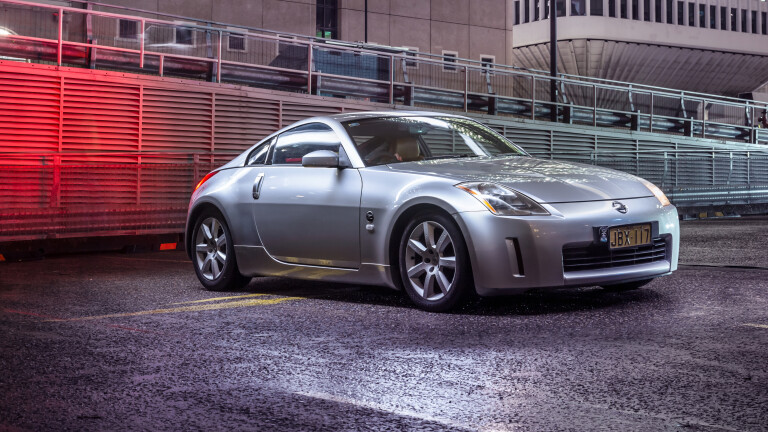
Following the Z32, Zed enthusiasts would have to wait another six years for the follow-up. Nissan USA, in late-90s, attempted to maintain the buzz by selling 37 ‘new’ fastidiously restored examples of the original 240Z, for US$27,000 with a 12-month/12,000-mile warranty.
The Z Concept was revealed in 1999 but the economic climate was vastly different, and it was ultimately deemed ‘too backward’ for a company in desperate need of financial security.
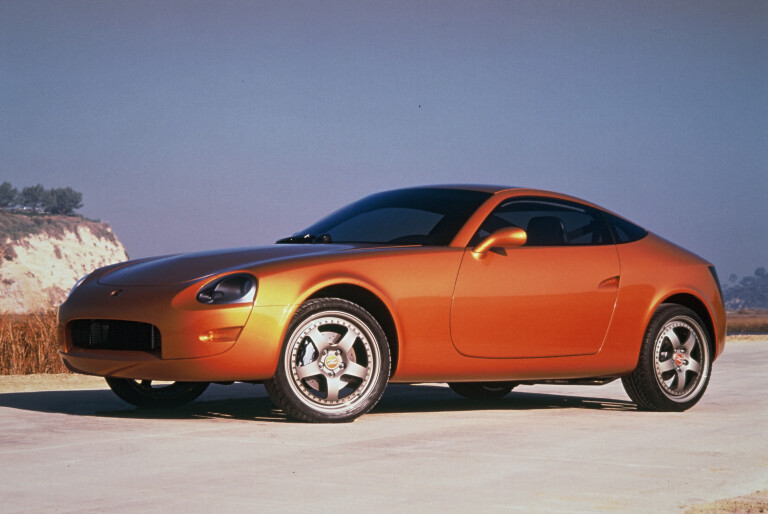
The Z33 350Z arrived midway through 2002, and was deemed by former CEO Carlos Ghosn as a car that would assist the company’s recovery into the future.
A modern interpretation of the iconic long bonnet and short rear deck silhouette, the 350Z was a dynamic delight, sneaking into fourth place at MOTOR’s 2004 PCOTY. Like many Zs before it, the Z33 found favour with various tuners and modifiers around the world, and makes a compelling case for an affordable ‘future classic’.
Sixth Generation: Nissan Z34 370Z – 2009-2020
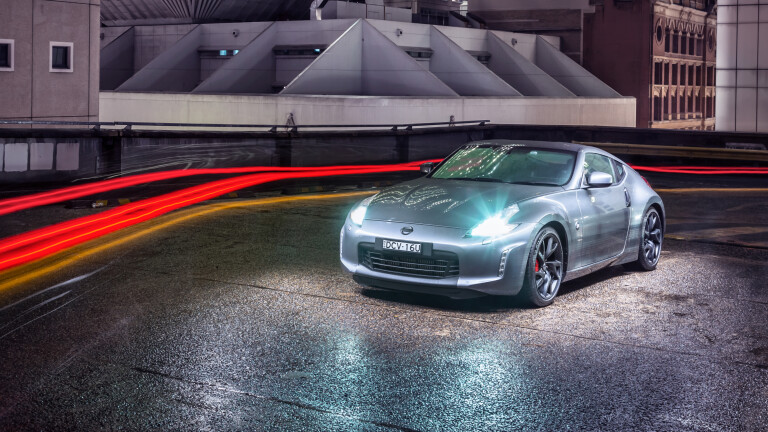
The Nissan 370Z represented a significant facelift of Nissan’s millennial star. The visual links are clear, however, look closer and you’ll notice that the car is shorter and wider with almost every panel redesigned.
More extensive use of aluminium throughout panels, engine cradle and subframes yielded a weight saving of 110kgs with a significant improvement to torsional stiffness.
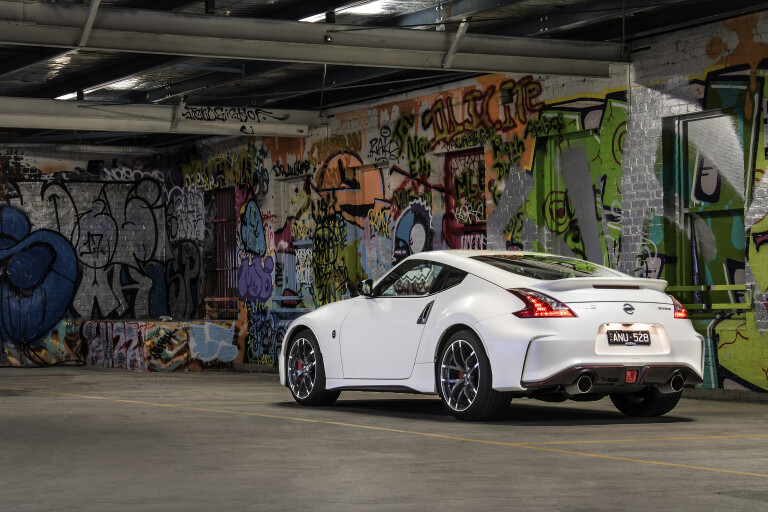
The VQ V6 now measured 3.7-litres in displacement and produced 261kW, making the 370Z the fastest Z-car yet.
Nissan’s SynchroRev Match which featured in manual cars from launch, represented the first auto-blip function ever fitted to a production car. Over 4500 have been sold since its introduction locally in 2009.
Despite its age, the driving experience still stands up today.
Seventh Generation: Nissan Z34 Z – 2021

The enduring Z legacy is set to continue, as the hotly-anticipated 2022 Nissan Z readies to launch midway through next year.
Gone is the old VQ37 V6, instead transplanting the thumping twin-turbo 3.0-litre VR30DDTT from the bombastic Infiniti Q60 Red Sport. On paper, it sounds like a winner: a sub-$100k sports car, almost 300kW, rear-driven with the choice of a manual gearbox.
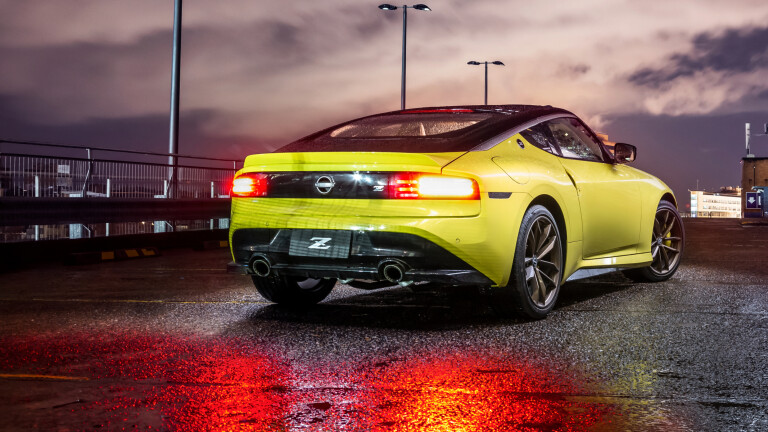
Final details including local pricing are yet to be confirmed, however Nissan has confirmed that Australia will receive a single-spec range, plus a Z Proto Spec launch edition, with some basic specs already revealed.
We love the way it looks, and will ultimately hold judgement until we finally get our hands on it, but the 2022 Nissan Z is already one of the cars we’re most eager to drive next year. As the car industry continues its march towards a greener future, the 2022 Nissan Z might be the last of its kind we ever see, and it could very well emerge as a car that the motoring fraternity will miss long after it’s gone.

COMMENTS